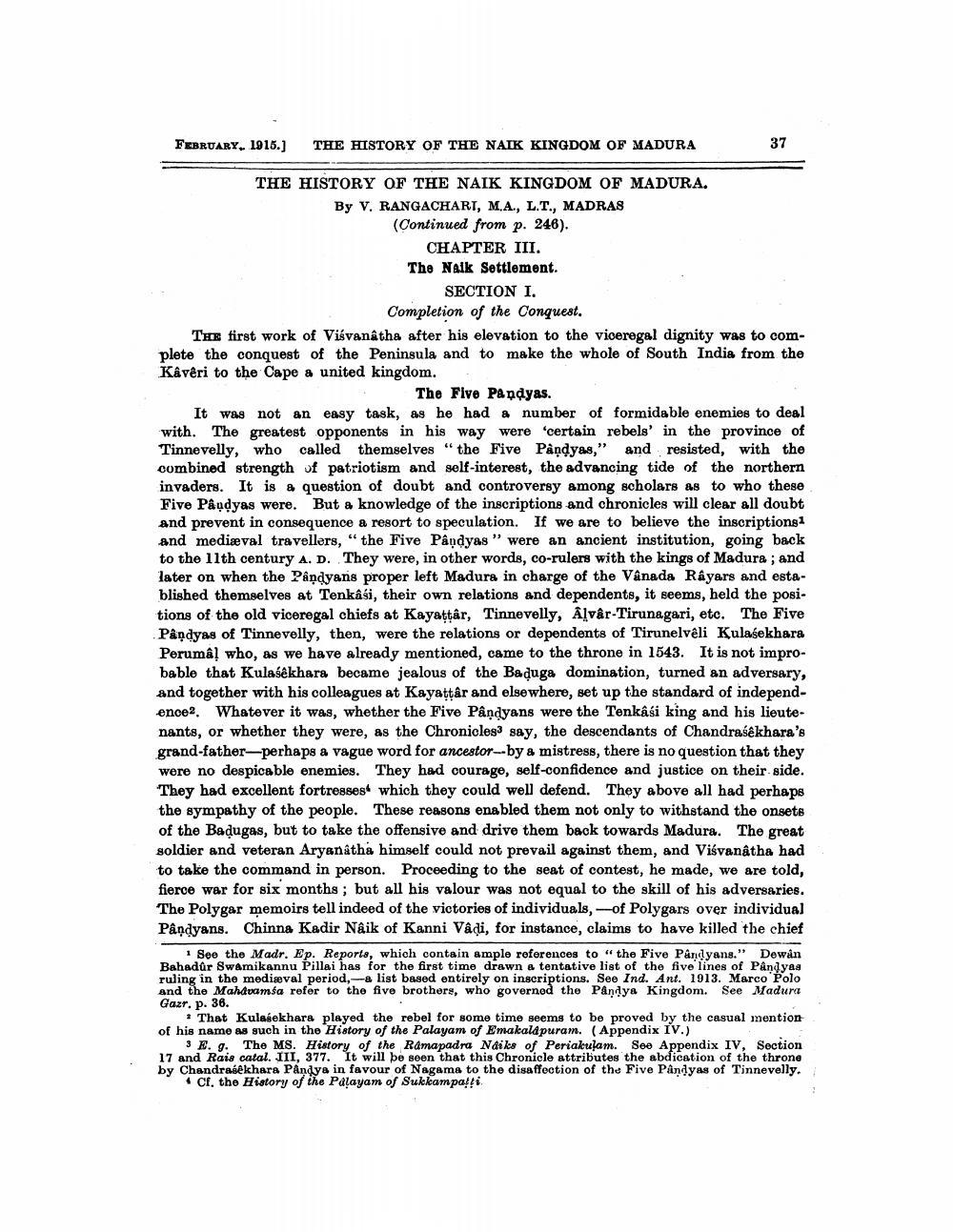________________
FEBRUARY, 1916.)
THE HISTORY OF THE NAIK KINGDOM OF MADURA
37
THE HISTORY OF THE NAIK KINGDOM OF MADURA.
By V. RANGACHARI, M.A., L.T., MADRAS
(Continued from p. 246).
CHAPTER III. The Naik Settlement.
SECTION I.
Completion of the Conquest. THE first work of Visvanatha after his elevation to the viceregal dignity was to complete the conquest of the Peninsula and to make the whole of South India from the Kaveri to the Cape a united kingdom.
The Five Pandyas. It was not an easy task, as he had a number of formidable enemies to deal with. The greatest opponents in his way were 'certain rebels' in the province of Tinnevelly, who called themselves “the Five Pâņdyas," and resisted, with the combined strength of patriotism and self-interest, the advancing tide of the northern invaders. It is a question of doubt and controversy among scholars as to who these Five Pâụdyas were. But a knowledge of the inscriptions and chronicles will clear all doubt and prevent in consequence a resort to speculation. If we are to believe the inscriptions and medieval travellers, "the Five Pandyas" were an ancient institution, going back to the 11th century A. D. They were, in other words, co-rulers with the kings of Madura ; and later on when the Pandyans proper left Madura in charge of the Vânada Rayars and established themselves at Tenkasi, their own relations and dependents, it seems, held the posi. tions of the old viceregal chiefs at Kayattâr, Tinnevelly, Alvår-Tirunagari, etc. The Five Pandyas of Tinnevelly, then, were the relations or dependents of Tirunelveli Kulasekhara Peruma! who, as we have already mentioned, came to the throne in 1543. It is not improbable that Kulasekhara became jealous of the Baduga domination, turned an adversary, and together with his colleagues at Kayattâr and elsewhere, set up the standard of independenoe2. Whatever it was, whether the Five Pandyans were the Tenkasi king and his lieutenants, or whether they were, as the Chronicles3 say, the descendants of Chandrasekhara's grand-father-perhaps a vague word for ancestorby a mistress, there is no question that they were no despicable enemies. They had courage, self-confidence and justice on their side. They had excellent fortresses which they could well defend. They above all had perhaps the sympathy of the people. These reasons enabled them not only to withstand the onsets of the Badugas, but to take the offensive and drive them back towards Madura. The great soldier and veteran Aryanatha himself could not prevail against them, and Visvanatha had to take the command in person. Proceeding to the seat of contest, he made, we are told, fieroe war for six months ; but all his valour was not equal to the skill of his adversaries. The Polygar memoirs tell indeed of the victories of individuals, --of Polygars over individual Pândyans. Chinna Kadir Naik of Kanni Vâdi, for instance, claims to have killed the chief
1 See the Madr. Ep. Reports, which contain ample references to "the Five Pandyans." Dewan Bahadur Swamikannu Pillai has for the first time drawn a tentative list of the five lines of Pandyas
t based entirely on inscriptions. See Ind. Ant. 1913. Marco Polo and the Mahavamsa refer to the five brothers, who governed the Pandya Kingdom. See Madura Gazr. p. 36.
That Kulasekhara played the rebel for some time seems to be proved by the casual mention of his name as guch in the History of the Palayam of Emakald puram. (Appendix IV.)
3 E. g. The MS. History of the Ramapadra Ndiks of Perialulam. See Appendix IV, Section 17 and Rais catal. III, 377. It will be seen that this Chronicle attributes the abdication of the throne
tasekhara Pandya in favour of Nagama to the disaffection of the Five Pandyas of Tinnevelly. Cf, the History of the Palayam of Sukkampalli




